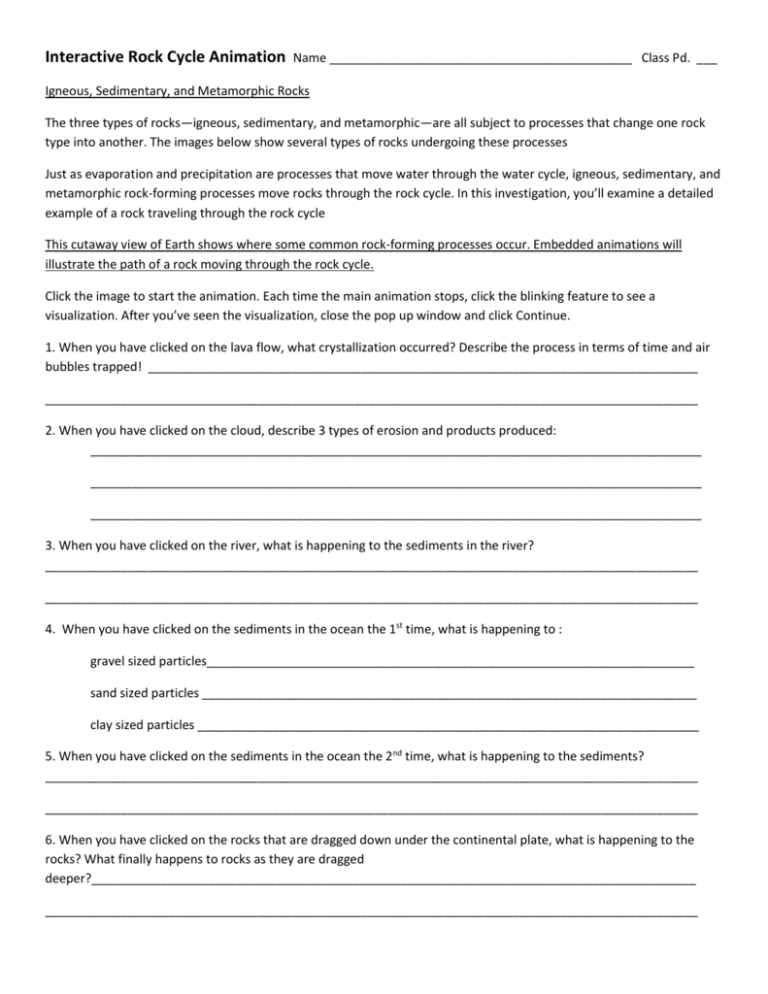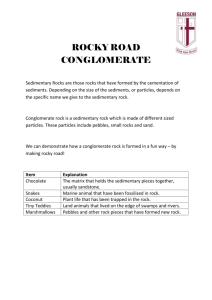Rocks & Rock Cycle Simulation
advertisement

Interactive Rock Cycle Animation Name ____________________________________________ Class Pd. ___ Igneous, Sedimentary, and Metamorphic Rocks The three types of rocks—igneous, sedimentary, and metamorphic—are all subject to processes that change one rock type into another. The images below show several types of rocks undergoing these processes Just as evaporation and precipitation are processes that move water through the water cycle, igneous, sedimentary, and metamorphic rock-forming processes move rocks through the rock cycle. In this investigation, you’ll examine a detailed example of a rock traveling through the rock cycle This cutaway view of Earth shows where some common rock-forming processes occur. Embedded animations will illustrate the path of a rock moving through the rock cycle. Click the image to start the animation. Each time the main animation stops, click the blinking feature to see a visualization. After you’ve seen the visualization, close the pop up window and click Continue. 1. When you have clicked on the lava flow, what crystallization occurred? Describe the process in terms of time and air bubbles trapped! ________________________________________________________________________________ _______________________________________________________________________________________________ 2. When you have clicked on the cloud, describe 3 types of erosion and products produced: _________________________________________________________________________________________ _________________________________________________________________________________________ _________________________________________________________________________________________ 3. When you have clicked on the river, what is happening to the sediments in the river? _______________________________________________________________________________________________ _______________________________________________________________________________________________ 4. When you have clicked on the sediments in the ocean the 1st time, what is happening to : gravel sized particles_______________________________________________________________________ sand sized particles ________________________________________________________________________ clay sized particles _________________________________________________________________________ 5. When you have clicked on the sediments in the ocean the 2nd time, what is happening to the sediments? _______________________________________________________________________________________________ _______________________________________________________________________________________________ 6. When you have clicked on the rocks that are dragged down under the continental plate, what is happening to the rocks? What finally happens to rocks as they are dragged deeper?________________________________________________________________________________________ _______________________________________________________________________________________________ Click NEXT at the bottom of the webpage! Move your cursor over the arrows to see a list of the rock-forming processes involved in forming the three types of rocks. The animations on the previous page show just one example of a rock moving through the rock cycle. The rock started as an igneous rock. Think about what the path of the example rock would look like in this diagram of the rock cycle. 1. Put the name of each process illustrated in the animation on the appropriate arrow. Keep in mind that the example on the previous page didn't show all the ways rocks move through the rock cycle. For instance, igneous rocks can become metamorphic rocks without reaching Earth's surface or becoming sedimentary rocks. Another variation from the example is that any type of rock can become a new rock of the same type. 2. Use your own words to describe the sequence of processes that result in igneous rocks. Describe a specific example of a sedimentary rock becoming an igneous rock. 3. Use your own words to describe the sequence of processes that result in sedimentary rocks. Describe a specific example of a sedimentary rock becoming a new type of sedimentary rock. 4. Use your own words to describe the sequence of processes that result in metamorphic rocks. Describe a specific example of a sedimentary rock becoming a metamorphic rock.








